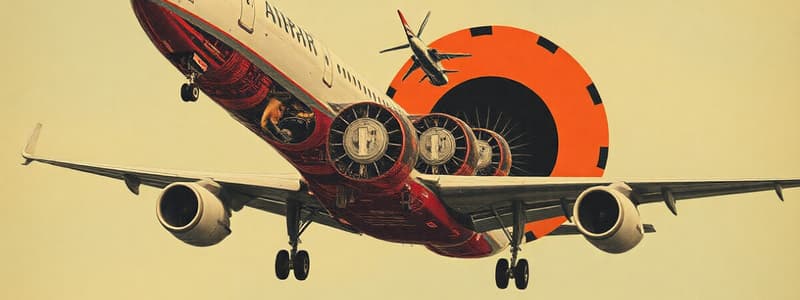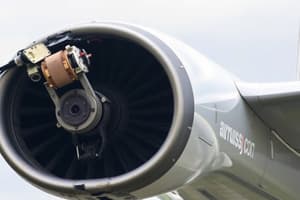Podcast
Questions and Answers
What was the main malfunction experienced by the Airbus A320 during landing?
What was the main malfunction experienced by the Airbus A320 during landing?
- Failure of both thrust reversers (correct)
- Autopilot failure
- Engine shutdown
- Landing gear malfunction
What did the cockpit crew receive indicating a failure?
What did the cockpit crew receive indicating a failure?
- Flight instrumentation alerts
- Landing gear fault messages
- Access door warnings
- ECAM messages (correct)
Which maintenance error was primarily responsible for the thrust reverser failure?
Which maintenance error was primarily responsible for the thrust reverser failure?
- Incorrect engine oil level
- Failure to remove quick release deactivation pins (correct)
- Low fuel pressure
- Improper flight planning
What type of pins should have been used instead of the quick release deactivation pins?
What type of pins should have been used instead of the quick release deactivation pins?
What role did the Maintenance Section Manager play in the incident?
What role did the Maintenance Section Manager play in the incident?
Why did the fitters use the incorrect deactivation pins?
Why did the fitters use the incorrect deactivation pins?
What did the A320 qualified technician falsely indicate in the EWIS inspection task card?
What did the A320 qualified technician falsely indicate in the EWIS inspection task card?
What was the technician's motive for signing off the task card as complete?
What was the technician's motive for signing off the task card as complete?
What oversight did the maintenance shift supervisor commit before releasing the aircraft to service?
What oversight did the maintenance shift supervisor commit before releasing the aircraft to service?
Which human factor contributed to the maintenance errors in the incident?
Which human factor contributed to the maintenance errors in the incident?
How did the pressure to minimize open tasks affect the maintenance team's performance?
How did the pressure to minimize open tasks affect the maintenance team's performance?
What was one of the main consequences of poor communication between maintenance shifts?
What was one of the main consequences of poor communication between maintenance shifts?
What impact did complacency have on the technician's actions?
What impact did complacency have on the technician's actions?
What role did a lack of knowledge play in the incident?
What role did a lack of knowledge play in the incident?
Which issue was highlighted as a breakdown in teamwork?
Which issue was highlighted as a breakdown in teamwork?
Which factor describes the maintenance team's response to the task pressure they faced?
Which factor describes the maintenance team's response to the task pressure they faced?
What resource management issue arose during the incident?
What resource management issue arose during the incident?
What was the overarching lesson from the thrust reverser incident?
What was the overarching lesson from the thrust reverser incident?
Flashcards
Incorrect Deactivation Pins
Incorrect Deactivation Pins
Using quick release deactivation pins instead of the designated safety pins with ‘Remove Before Flight’ streamers.
Lack of AMM Consultation
Lack of AMM Consultation
Failing to consult the Aircraft Maintenance Manual (AMM) for the correct procedure to deactivate the Thrust Reverser (TR) systems.
Unqualified Fitters and Lack of Supervision
Unqualified Fitters and Lack of Supervision
The fitters were unqualified, not properly supervised, and did not consult the AMM for the correct procedure.
Improper Task Sign-Off
Improper Task Sign-Off
Signup and view all the flashcards
Intention to Delay Reactivation
Intention to Delay Reactivation
Signup and view all the flashcards
Thrust Reverser Systems Deactivation
Thrust Reverser Systems Deactivation
Signup and view all the flashcards
TR Systems Deactivation Error
TR Systems Deactivation Error
Signup and view all the flashcards
Improper Pin Removal
Improper Pin Removal
Signup and view all the flashcards
Failure to Follow AMM Procedures
Failure to Follow AMM Procedures
Signup and view all the flashcards
Pressure to Minimize Open Tasks
Pressure to Minimize Open Tasks
Signup and view all the flashcards
Lack of Communication
Lack of Communication
Signup and view all the flashcards
Complacency
Complacency
Signup and view all the flashcards
Lack of Knowledge
Lack of Knowledge
Signup and view all the flashcards
Distraction
Distraction
Signup and view all the flashcards
Lack of Teamwork
Lack of Teamwork
Signup and view all the flashcards
Pressure
Pressure
Signup and view all the flashcards
Lack of Resources
Lack of Resources
Signup and view all the flashcards
Stress
Stress
Signup and view all the flashcards
Study Notes
Airbus A320 Thrust Reverser Failure - Study Notes
- Incident Date: January 21, 2024
- Aircraft: Airbus A320 (HZ-XXXX)
- Flight: SV-XXX from Riyadh (RUH) to Jeddah (JED)
- Failure: Both engine thrust reversers failed upon landing.
- ECAM Messages: "ENG 1 reverser fault" and "ENG 2 reverser fault" received in the cockpit.
- Cause: Incorrect deactivation pins (
PN: HIX3008) were used, and necessary safety pins with red streamers (Remove Before Flight) were not employed.
Maintenance Failures
- Incorrect Deactivation Pins: Maintenance team used quick-release pins, instead of the required safety pins (PN: HIX3008).
- Quick-release pins were readily available in the thrust reverser assembly.
- Correct, safety pins with “Remove Before Flight” streamers were available but not used.
- Improper Supervision: The Section Manager bypassed the standard supervisory chain, which removed oversight for the unqualified fitter team. A team of three unqualified fitters was assigned.
- Falsified Task Sign-Off: A qualified A320 technician falsified an EWIS inspection task card, inaccurately stating the TR systems were reactivated.
- The technician likely did this to reduce open tasks and work orders. The TRs were intended to remain deactivated for a subsequent maintenance task. This highlights the danger of assumptions in aircraft maintenance and the importance of clear communication.
- Failure to Follow AMM Procedures: The maintenance shift supervisor failed to remove the deactivation pins prior to releasing the aircraft for service. This oversight was a critical failure to meet established protocols.
- The supervisor also conducted a final engine leak check without removing the safety pins.
Root Causes: "Dirty Dozen" Human Factors
- Lack of Communication: Poor communication between maintenance teams and shifts.
- Complacency: Technician falsified a sign-off with assumptions.
- Lack of Knowledge: Unqualified fitter team lacked necessary expertise.
- Distraction: Minimizing open tasks may have distracted the maintenance team from proper procedures.
- Lack of Teamwork: Bypassing the supervisory chain and assigning an unqualified team impacted teamwork.
- Pressure: Pressure to minimize open tasks may have contributed to shortcuts and procedural violations.
- Lack of Resources: Needed deactivation pins were not secured, highlighting a deficiency in resource management.
- Stress: Pressure to meet time constraints can lead to mistakes.
- Lack of Assertiveness: Team members failed to challenge improper procedures or use of inadequate pins.
Systemic Issues
- Unclear Roles and Responsibilities: Maintenance department roles and responsibilities were poorly defined. This resulted in the Section Manager overriding the shift supervisor's authority.
- Ineffective Communication: Lack of communication between maintenance teams and shifts prevented crucial information from being relayed, leading to the incident.
Studying That Suits You
Use AI to generate personalized quizzes and flashcards to suit your learning preferences.




